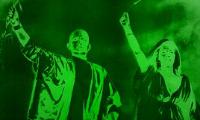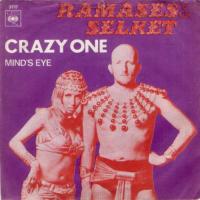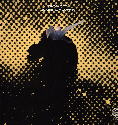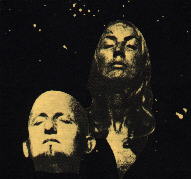Biography:
A Brief History
by Nigel Camilleri If there ever had to be a list of the most eclectic musicians/rock groups, then Ramases would be a definite contender. Very little is known about this enigmatic person, and very little in terms of music was ever produced. However, his two albums, especially the first one, have built up a form of cult following within progressive rock circles.
If there ever had to be a list of the most eclectic musicians/rock groups, then Ramases would be a definite contender. Very little is known about this enigmatic person, and very little in terms of music was ever produced. However, his two albums, especially the first one, have built up a form of cult following within progressive rock circles.
Born in the late thirties, in Sheffield, England, Martin Raphael (also sometimes known as Barrington Frost) worked as a PT instructor in the army after serving a conscription period and after that started a lucrative business as a central heating salesman in Scotland. One day, whilst in his car he claimed to have had a vision from the Egyptian Pharaoh god Ramases, who informed him that he was actually the re-incarnation of this deity and that his duty on earth was to inform the world the truth about the universe. (This has been corroborated by various people such as artist Roger Dean and musician Eric Stewart amongst others.)
 The next step for Martin Raphael was to change his name to that of his "original" self, Ramases and try to get himself a recording contract so that he could preach his views via the musical world. Incredibly so, he managed to obtain a recording contract with CBS and released a single (CBS 3717) in 1968 together with his wife under the moniker Ramses And Selket. The tracks featured were Crazy One with Mind's Eye on the B-side. The original title was to be Quaser One, but there was a misunderstanding with the operator at the recording company with the resultant single having a different title! This single was also made available on volume 3 of the new Rubble Series which has now been released by Voiceprint Records. This single is the rarest of Ramases material valued at £70 (British Pounds Sterling) by the Record Collector Magazine.
The next step for Martin Raphael was to change his name to that of his "original" self, Ramases and try to get himself a recording contract so that he could preach his views via the musical world. Incredibly so, he managed to obtain a recording contract with CBS and released a single (CBS 3717) in 1968 together with his wife under the moniker Ramses And Selket. The tracks featured were Crazy One with Mind's Eye on the B-side. The original title was to be Quaser One, but there was a misunderstanding with the operator at the recording company with the resultant single having a different title! This single was also made available on volume 3 of the new Rubble Series which has now been released by Voiceprint Records. This single is the rarest of Ramases material valued at £70 (British Pounds Sterling) by the Record Collector Magazine.
Next single, this time under the name of Ramases And Seleka, to be released would be on a much smaller label, Major Minor (MM 704), with Love You on the A-side, backed by Gold Is The Ring, in 1968. (valuation £15). Some sources cite a single released in Germany at the same time with the title Screw You, though this was probably the same single as Love You, and the name mis-spelt or mis-heard. Apparently these tracks also appeared on the Exploding Plastic Inevitable Volume 2 compilation album.

What is a definite fact, is that in 1970, Ramases signed a deal with Vertigo, which was the progressive branch of Phillips. Recordings for an album took place at Strawberry Studios in Stockport. Owned by the future members of 10CC, this is what probably gave this album the cult status it currently has. Four members of this group (which would be formed in 1972) played and most definitely had a hand in the musical input to the album, They were Eric Stewart, Lol Creme, Kevin Godley and Graham Gouldman. The album had a lavish cover, which folded out into a large cardboard poster, designed by Roger Dean.
Two singles were released from this album in 1971. First out was Ballroom backed by Muddy Water (Phillips 6113 001; valuation £15). Once again there probably was a typing error as it seems that Ramases never wrote a song titled Ballroom, but one called Balloon which eventually appeared on Space Hymns. Next single had two tracks which would find there way onto the album , Jesus Come Back and Hello Mister (Phillips 6113 003).
Space Hymns was released on the Vertigo label (6360 046) in 1971, and is a rather strange sounding album for this label as it possesses none of the normal musical traits usually characteristic to Vertigo. Musically speaking it sounds somewhat folksy having a strong hippy commune feel, very different to the the jazz tinged bands or the heavy/hard rock bands that characterized this label. The album created a certain amount of hype within certain rock circles especially with those who were fans of the more psychadelic leaning style of progressive rock. The main areas of popularity were England and Germany were there was always a certain amount of affinity for rock bands who tried to fuse their music with certain cults especially Middle Eastern religions (A classic example would be the group Quintessence). The album with the spiral label; has become a collectors item fetching £30, while the spaceship label would fetch something in the region of £18.
Following the release of Space Hymns, Ramases and his wife moved to Stanley Road,Felixstowe in Suffolk where he lived in a house together with his mother. Very little was heard from him until 1975, when he released his second album which was rather different to Space Hymns having a musical feel slightly skin to that of early Strawbs material.

According to friend and neighbour, Paul Hollyer (read Paul's story here...), Ramases was very disappointed with the cover of Glass Top Coffin (Phillips 6360 115; Valuation £15). The original intention was to have a cut out showing a man falling backwards into space into the Horsehead nebula. When the gatefold cover was to be opened up, this was to reveal a bird. the record company would not change the artwork as this was already done. However he managed to obtain permission to modify the lithographs and create an impression that the man falling backwards was wearing a spacesuit with helmet on. The album, however sunk without a trace as did Ramases and his wife Sel.
Little is known about Ramases following the release of Glass Top Coffin. He seems to have slipped into obscurity, remaining in Felixstowe. Reports in the nineties quote Ramases as having died, with suicide being the cause of death.
This brief history originally appeared on the Dutch Progressive Rock website and is reprinted here by the kind permission of Nigel Camilleri.
See some Newspaper articles here...
INTRODUCTION |BIOGRAPHY |DISCOGRAPHY |FORUM |LINKS
